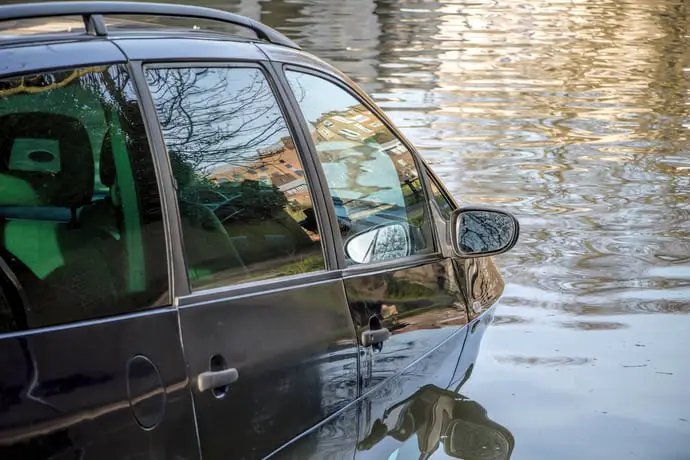Last Updated on August 26, 2022 by

Drying and cleaning a flooded car might seem like a daunting task, but the sooner you tackle it, the more likely it is that you can have your car back in good shape quickly. Water damage can occur as a result of driving through a flooded street, leaving the windows or sunroof open during a storm, a faulty seal in the car, or even a car accident that leaves your car submerged in water. No matter the reason, water damage can lead to mould, mildew, corrosion, and a number of other difficult problems. It is imperative that the vehicle is dried out and cleaned right away to avoid possible long-term damage.
Clear Out the Car
Before doing anything else, you need to clear out everything you have in the car. Remove everything that is not attached to the car. If your rear seats come out, take them out. Remove all of your personal possessions and anything else that you can. It will be easier to clean and dry the interior of the car.
Assess the Damage
The next step is to check for damage to the electrical and mechanical systems. Electrical damage can be extremely dangerous, so it might be best to have a professional check your car to make sure it is safe. Water can cause problems with the wiring, the power seats and windows, and the computers in the car.
In addition, you need to check for mechanical damage. Water damage can cause corrosion, which often leads to other mechanical issues. You should call a professional if you find that your car is stalling or not working properly after the water damage. Check the brakes, starters, and other parts under the hood.
Finally, go through the entire interior of the car. Determine how much water is standing in the car and which parts of the interior are wet. Make sure that you look everywhere, even under the seats and inside the compartments and consoles. It is crucial to find all of the affected spaces in the car.
Dry Out the Car
Once you have assessed the extent of the damage, it is time to dry out the car. You will need to dry out any part that is wet. Some cars have a drain plug on the floor. If your car has one, unplug it to let any standing water out. If you do not have a plug, use a bucket to remove as much water as possible before you begin. A wet/dry vacuum can be very useful once the majority of the water is gone. Dry the interior until there is minimal dampness remaining.
Next, you will want to use a towel to dry the places that are damp. Cloth towels are the best choice because they are more absorbent than paper towels. Take the cloth towel and blot the areas that are damp. This includes the upholstery on the seats, the doors, the carpeting, and any other spot that has any moisture at all. Wipe down the door panels and the centre console. When the car is as dry as it can be with a towel, you can move to the next step.
Finally, open the doors to the car, and set a large fan on one side. You can run an extension cord to the car and plug in a box fan or a big shop fan if you have access to one. Turn the fan on high, and its airflow will take away the remaining dampness. On some cars, it is possible to raise the carpet flooring, and this will speed up the process. Ideally, you will leave the fan on the car for 24 hours. If it is not possible to leave the car open with the fan on, you can turn the car on and turn the heater on full blast. This will have the same effect of drying the car.
Clean the Car
Now that the car is dry, it is time to clean it. There may be a musty odour that lingers after it is dry. You will want to clean the upholstery first. If the car has cloth seats, use upholstery cleaner, and use a specialised leather product for leather. In addition, use soap to wipe down the doors and console. Shampoo all of the upholstery and the carpeting. It may seem redundant to dry the car before you clean it out, but shampooing the car will kill any remaining bacteria and leave the car smelling fresh again.
Once you have thoroughly cleaned the car, use an ordinary hair dryer to finish the job. Make sure that you dry the seats, the floor, and any upholstery on the door panels or in the back. You can sprinkle baking soda on areas that are still damp. Baking soda absorbs moisture and will help to prevent bacteria and mould from growing. Once these spots are dry, you can vacuum the baking soda out of the car.
You will also need to clean any parts that you removed from the car. They should be cleaned and dried just as the interior has been before you return them to the car.
Put the Car Back Together
Now that your car is clean and dry, you can replace everything you took out of it. Sprinkle baking soda under the rear seat before you install it. If the floor mats still have an odour, you may need to replace them, but this is a fairly simple task. You can purchase new floor mats at almost any automotive store.
When a car has been flooded, it is important to assess the damage, dry it out, and clean it as soon as possible. Water damage can lead to mechanical and electrical problems. The moisture can lead to corrosion, mould, mildew, and a host of other bigger problems. As long as you follow the steps listed above, your car should be back on the road in no time at all.
